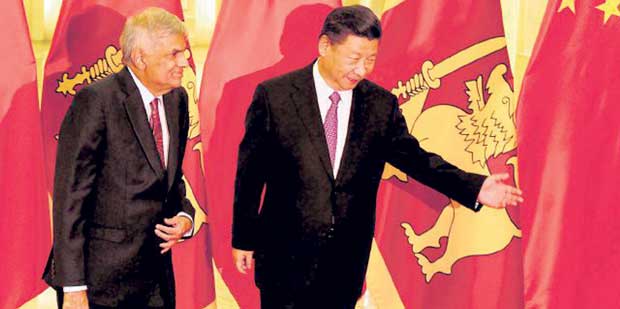25 May 2017 - {{hitsCtrl.values.hits}}

 China’s ambitious Belt and Road Initiative (BRI) sets the bar high. It strives to connect Asia, Africa and Europe with the aim of achieving mutual development. Sri Lanka, with its valuable geographic position in the heart of the Indian Ocean, is a crucial participant in Beijing’s newest endeavour.
China’s ambitious Belt and Road Initiative (BRI) sets the bar high. It strives to connect Asia, Africa and Europe with the aim of achieving mutual development. Sri Lanka, with its valuable geographic position in the heart of the Indian Ocean, is a crucial participant in Beijing’s newest endeavour.
But China–Sri Lanka ties seemed to reach a low point when in January 2017 violent protests erupted in which people expressed opposition to an industrial zone project funded by Beijing. This turbulent and unpredictable bilateral engagement provides China a valuable lesson for building the Belt and Road.
China tries its best to convince the rest of the world that it is a fundamentally different kind of great power. This idea is partly underpinned by the ‘Five Principles of Peaceful Coexistence’ that guided China’s post-1949 foreign policy. One of the core concepts of this engagement is non-interference with other countries’ internal affairs. A further pillar of China’s self-perception of being a benign great power is ‘win-win’ cooperation that is beneficial for all partners.
An archetypical manifestation of this thinking is the BRI. China’s proposal entails deepened financial, political, infrastructural, commercial and cultural ties between Beijing and the more than 60 other participants. The main idea is that China shares the fruit of its development for the sake of mutual progress. According to the official narrative, the BRI is not a geopolitical tool to extend Beijing’s influence and everybody is a winner under the novel cooperation framework.
Against this background, it is hard to believe that anything could go wrong. Yet in Sri Lanka — one of the BRI’s flagship participants — public discontent erupted in a violent protest. The case of Sino–Sri Lankan relations proves that if non-interference equates to an ignorance of domestic dynamics, then China’s hands-off foreign policy can cause more harm than good.
In order to make sense of the recent developments in China–Sri Lanka ties, one has to take a step back and look at the aftermath of the nearly three-decade long Eelam War. The bloody conflict left Sri Lanka in ruins, forcing the little island nation to rely on external actors to rebuild itself. Sri Lanka’s post-civil war history has been chiefly shaped by the duality of the Beijing and Washington Consensus. While Washington’s helping hand comes with rigid conditionality, Chinese aid and investments seem to come with no strings attached.
In 2009, the civil war came to a brutal end at the hands of Mahinda Rajapaksa who subsequently became the subject of allegations of human rights violations, corruption and nepotism. Given its dubious reputation, the Rajapaksa regime quickly ran out of friends and the Beijing Consensus was a convenient and reliable source of funds. China–Sri Lanka relations reached new heights. Chinese signature projects such as the Mattala airport, Hambantota port and Colombo port city were built with billions of dollars of Chinese funds.
This engagement, also known as the ‘Colombo Consensus’, was indeed a win-win cooperation. Rajapaksa could rely on the steady flow of Chinese money to solidify his power and Beijing gained access to one of the most valuable geostrategic positions in the Indian Ocean.
All of this led observers to believe that Rajapaksa had cemented his power for a very long time to come. Yet such assumptions proved wrong. In a surprising triumph of democracy, Maithripala Sirisena, a former ally of Rajapaksa, gained power and became the new President of Sri Lanka in January 2015. The novel leader’s promises included a revision of ill-famed Chinese projects, including the Colombo Port City project, a massive initiative costing more than a billion dollars.
But it is hard to keep such promises once one is bound by legal contracts. Sri Lankan debt exceeds US $ 60 billion, more than 10 percent of it owed to the Chinese. Beijing was irked by the new government’s attitude and played hard during negotiations over the Hambantota Port project, squeezing out a deal that would have given China Merchants Port Holdings 80 percent of the stakes in the project and control over the adjacent industrial zone covering 15,000 acres of land.
Now Beijing’s strongman approach has backfired. The new conditions of the Hambantota project met strong opposition from the Sri Lankan public. As a result, new negotiations started that decreased China’s stake by approximately 20 percent.
The case of Sri Lanka leaves Beijing with one key takeaway that is worth pondering as it embarks on an initiative that covers the majority of the planet. While there is nothing wrong with the idea of not meddling with other countries’ internal affairs, it does not mean that Beijing should be insensitive toward the domestic dynamics of its partners. Simply channelling exorbitant amounts of money into other countries is not going to be enough for realising the New Silk Roads. The implementation of the initiative calls for something more — understanding and adapting to the internal processes of BRI participants.
Beijing has already burnt itself in Myanmar, Thailand and Laos, where the public is becoming hostile to Chinese projects. Like a chain, the Belt and Road is as strong as its weakest link and public perceptions toward China can become an existential issue for Beijing’s ambitious initiative.
(Courtesy East Asia Forum)
(Dániel Balázs is a recent graduate of international relations at Tongji University in Shanghai. The views expressed are his own and do not represent the views of his affiliated institution)
08 Jan 2025 31 minute ago
08 Jan 2025 1 hours ago
08 Jan 2025 3 hours ago
08 Jan 2025 4 hours ago